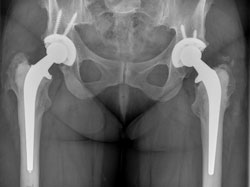Highly crosslinked polyethylene in THA shows reduced wear at mid-term follow-up
NEW ORLEANS — Results of two randomized radiostereometry studies conducted by Swedish investigators showed highly crosslinked polyethylene wore less than conventional polyethylene in total hip arthroplasty at 7-year follow-up, but proximal penetration of femoral heads into the cups significantly increased between 5 and 7 years, indicating some deformation or wear.
Per-Erik Johanson, MD, of Gothenburg, Sweden, presented results of this study at the 2010 Annual Meeting of the American Academy of Orthopaedic Surgeons, here.
“There seems to be a slow, constant wear of highly crosslinked polyethylene at 7 years in these evaluations. We will need further follow-up to see if this will reflect in any alterations in the rates of osteolysis in the two groups,” he said.
The first study involved 32 patients with primary osteoarthritis who underwent bilateral simultaneous total hip arthroplasty (THA). Patients were randomized to receive a highly crosslinked polyethylene (PE) liner or a conventional PE liner on their most painful side. They received the other type of liner for the THA done on their contralateral hip.
Penetration comparison
Tweny-five patients completed their 7-year evaluations.
 Radiograph of bilateral THA from the hybrid study at 7-year follow-up. The patient received a conventional PE liner on the left side and a highly crosslinked PE liner on the right. Image: Johanson PE |
Based on a radiostereometry analysis with patients in the supine position, “We can see the proximal penetration at 7 years in the highly crosslinked group was significantly reduced compared to controls,” Johanson said.
Cemented study
In the second randomized study, which involved cemented THA components, 26 patients received highly crosslinked cups and 28 control patients received conventional PE cups.
“Also here we see a reduced proximal penetration at 7 years,” Johanson noted.
In the hybrid study, mean proximal penetration was 0.13 mm in the highly crosslinked group and 0.45 mm in the control group.
The cemented study showed average proximal penetration of 0.22 mm in the highly crosslinked group and 0.51 mm in the control group.
Johanson and colleagues previously reported no detectable wear in either of the groups’ highly crosslinked PE components in these randomized THA studies, after the initial bedding-in period. – by Susan M. Rapp
References:
- Johanson P-E, Karrholm JN, Digas G, et al. Highly cross-linked polyethylene in total hip arthroplasty seven years follow up. Paper 109. Presented at the 2010 Annual Meeting of the American Academy of Orthopaedic Surgeons. March 9-13, 2010. New Orleans.
- Per-Erik Johanson, MD, can be reached at Sahlgrenska University Hospital, Department of Orthopaedics, Gothenburg, Sweden SE-41345; 46-31-342-1000; e-mail: per-erik.johanson@vgregion.se. He receives research/institutional support from Biomet, Link, Smith & Nephew, Stryker and Zimmer.
